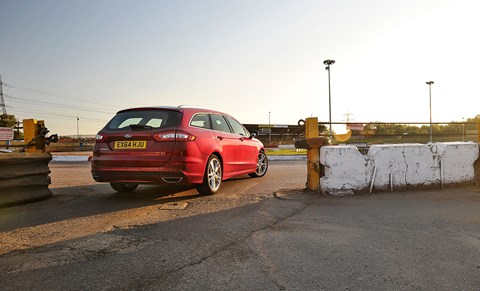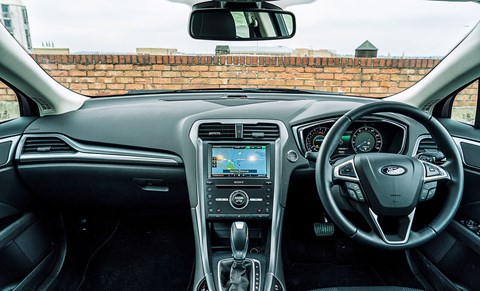► Month nine living with the Ford Mondeo
► Time to say goodbye to our trusty diesel estate
► Despite being inferior to many rivals, it’ll be missed
Much like Christmas is for kids, the Mondeo was a long time coming, and gone all too soon. Ford in the US released its version, the Fusion, at the beginning of 2014, but Europe had to wait a whole year for the Mondeo-ised car with its more suitable engine range. Now, after nine months on the fleet, we’ve swapped ours for another Ford and are about to find out how much we’ll miss it, if at all.
That we’ve replaced it with a new S-Max pretty much sums up the Mondeo’s problem, one all traditional family cars face. No matter how good the Mondeo is, far fewer drivers actively choose one, its ‘Mondeo man’ market eroded by the lure of premium badging and more versatile MPVs and SUVs. In its heyday Ford sold well over 100,000 Mondeos in the UK each year; now it’s less than 30k because no-one wants an ‘ordinary’ car.
That’s always been the Mondeo’s conceit, though. Right from the beginning in 1993 it looked ordinary, when to drive, and to live with, it was anything but. This time the Mondeo looks far from ordinary. Wide, and sleek, square-jawed and confident, it’s a fantastic looking car, whether you go for the rakish fastback hatch or handsome wagon. This time the Superman suit is on the outside, not hidden away. The question is, is it plain old Clark Kent underneath?
First impressions suggested it was the Man of Steel through and through (aluminium hasn’t yet made it below the premium sports saloon market). The cabin is vast and brilliantly hushed at speed, which has historically been a Ford weakness. Since my driving diary basically involves endless long airport runs punctuated by shorter ones ferrying kids around, that’s a pretty appealing combination. The boot isn’t the biggest in the class but seemed big enough to swallow family junk too, including bikes, which was handy because my bike rack didn’t fit because of the Mondeo’s fat bootlid lip, and the long service intervals proved equally practical. The car went back at 13,000 miles, still with 5000 to go before needing its first oil change.

We went for the top-dog (at the time) 178bhp 2.0 TDCi, and although I was initially less than amazed by its kick (the 8.7sec 0-62mph time compares badly with the equivalent Passat’s 7.9sec) and its struggle to average 40mpg, it proved gutsy in the mid range and the 450+ mile range was welcome. As was the smooth-shifting twin-clutch transmission, which did a great job of maximising the engine’s 295lb ft of torque, and whose mapping was so good I rarely touched the steering-wheel paddles, preferring to stir the stick between Drive and Sport as needed. And economy did improve as the engine loosened up. Disappointing 38s became more acceptable 40s, although even driving like we had 300 gallons of unset jelly sloshing around in the boot, 50mpg proved impossible to achieve.
Some CAR staffers reckoned the old Mondeo dynamic magic was equally elusive. The fact that there’s a dedicated Sports suspension option in the brochure backs up the subjective feeling that the standard set-up has been softened. We’re not talking mush here. Fully laden and tanking on, the body control was too soft, but in normal use it seemed well judged, and still displayed the kind of steering feel, precision and sense of involvement you simply don’t get in a Passat.
What you do get with the Passat though, is a genuinely premium-feeling cabin. It’s not so much the Ford’s design that’s at fault, but the materials that spoil the experience. The Mondeo is less claustrophobic but it looks and feels cheaper (though doesn’t sound it, not with our car’s excellent optional Sony hi-fi). A familiar gripe? Fifteen years and two generations ago we were saying exactly the same thing.
But 15 years ago kit like lane-keeping assist, collision warning systems and airbag seatbelts were still concept car material. Now they’re available to everyone, but do you want them? We tried to leave the steering assist (which warns if you’re about to leave your lane and can actively steer you to keep you from straying) switched on because, like ESP, there’s no point in having it otherwise. But it was simply too annoying and too inconsistent. Sometimes the steering correction makes the front end feel as wayward as an Alfa 4C. Great idea, best avoided.

Much like the arthritic touchscreen sat-nav, whose cursor is about as enthusiastic about being dragged across the map as London social housing evictees. And the airbag seatbelts are best avoided too if you’ve got small kids, something I can only say because I never needed their help. My kids though, needed help to put the belts on every time we travelled. If you want to see rage like you’ve never seen rage before, watch a seven-year old trying to wrestle one of the airbag belt’s strangely fat buckles into a socket that’s not mounted remotely wide enough to work with a proper child seat. Given the car’s family-friendly intentions, it seems a strange gaffe.
Count up those demerits, the fact that a Passat is quicker, more economical and feels more special inside, or that you could have a thinly specced BMW 3-series wagon for the £31k our car cost, or a more practical and more fashionable SUV and you can see that the Mondeo’s glory days are over. But you know, I’m going to miss it, the relatively uncomplicated dependability, the elegantly understated styling and cleaning that giant chrome grille with my little boy until it absolutely gleamed. And when it did, I felt a little proud, not a familiar feeling for Mondeo man, I’m fairly sure.
Count the cost
Cost new: £31,135 (including £4270 of options/as tested)
Dealer sale price: £25,583
Private sale price: £24,198
Part-exchange price: £22,703
Cost per mile: 13p
Cost per mile: including depreciation 82p
Logbook: Ford Mondeo Titanium 2.0 TDCi
Engine: 1997cc 16v diesel, 178bhp @ 3500rpm, 295lb ft @ 2000rpm
Gearbox: 6-speed dual-clutch auto, front-wheel drive
Stats: 8.7sec 0-62mph, 135mph, 130g/km
Price: £26,865
As tested: £31,135
Miles this month: 1183
Total miles: 12,678
Our mpg: 40.1
Official mpg: 56.5
Fuel cost overall: £1654.25
Extra costs: £0